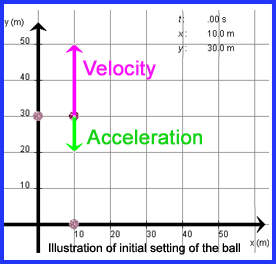A3: Activities on Vertical Launch Without Air Resistance
Place the ball at (x,y) = (10,30) m. This point will be referred to as the "launch point."
Make the following settings for the ball (see the figure below).
vx (0) = 0, vy (0) = 20.0 m/s
C = 0, m= 0.1 kg; these last two are
set automatically when you load the applet.
Launch the ball, and observe how the velocity and 
acceleration vary in time. Also observe the x and y components and magnitude of the velocity (speed) as displayed
in the control panel. Then answer the following questions:
1. During the motion, the x-component of the velocity vector of the ball is 0 at all times and the y-component
is
(a) decreasing on the way up, 0 at the top, and decreasing on the way down
(b) decreasing on the way up, 0 at the top, and increasing on the way down
(c) increasing on the way up, 0 at the top, and decreasing on the way down
2. During the motion, the x-component of the acceleration vector of the ball is 0 at all times and the y-component
is
(a) positive on the way up, 0 at the top, and negative on the way down
(b) negative on the way up, 0 at the top, and negative on the way down
(c) negative at all times
(d) positive at all times
3. Determine the average acceleration over a 0.2-s time interval that
encloses the instant when the ball is at the top. Use the Step button with the time step set to 0.2 s to accomplish
this.
The acceleration (ax,ay) during this time interval,
to the accuracy given by the applet, is
(a) (0, 10.0) m/s2
(b) (0,-10.0) m/s2
(c) (0,0) m/s2
4. The ball's acceleration when the ball is leaving the launch point,
when it is at the top, and when it is returning to the launch point has
(a) the same magnitude at all three instants
(b) has the same magnitude when the ball leaves from and returns to the launch point, but a different magnitude
at the top
(c) different magnitudes at all three instants
5. The ball's acceleration when the ball is leaving the launch point,
when it is at the top, and when it is returning to the launch point
(a) has the same direction at all three instants
(b) has the same direction when the ball leaves from and returns to the launch point, but the direction is undefined
at the top because the acceleration is zero at this point
(c) has different directions when the ball leaves from and returns to the launch point
6. Compare the times elapsed while the ball is moving from the launch
point up to the top and while the ball is moving from the top back down to the launch point. The time for upward
motion of the ball is
(a) equal to the time for downward motion
(b) less than the time for downward motion
(c) greater than the time for downward motion
7. Calculate the ball's speed at the point that is half way to the maximum
height, both when the ball is on its way up and when it is on its way down.
8. If you increase the vertical launch speed by a factor of 1.5, the time to
reach the top
(a) increases by the same factor
(b) increases by the square of 1.5
(c) increases by the square root of 1.5
Shadow Balls
Observe that the motion of the shadow balls in relation to the motion the ball,
and answer the following questions:
9. Why does the shadow ball on the
x-axis remain stationary when the actual ball is moving?
10. The motion of the shadow ball on
the y-axis looks identical to that of the actual ball. Does
this mean that your findings in questions 1 through 8 are also
applicable to the shadow ball on the y-axis?
(a) yes
(b) no
